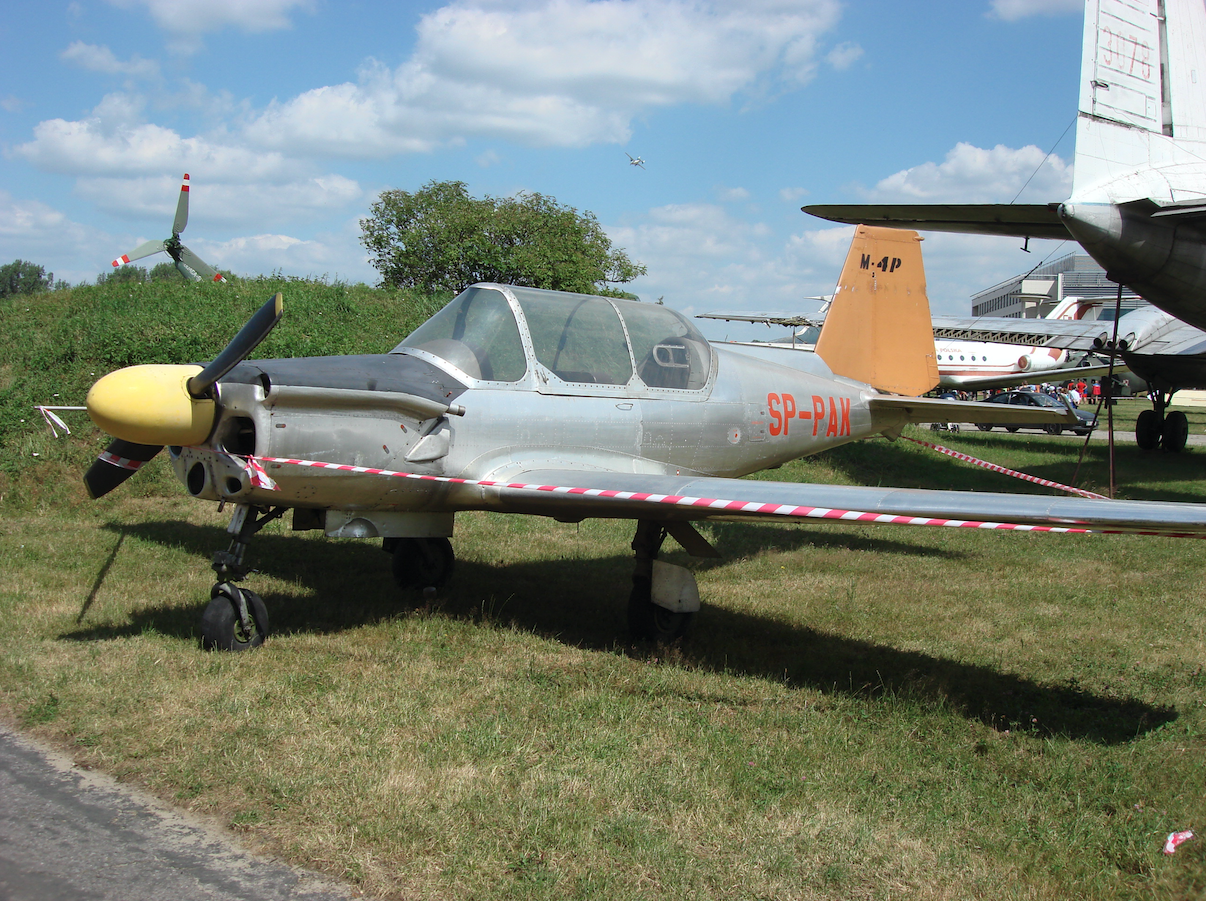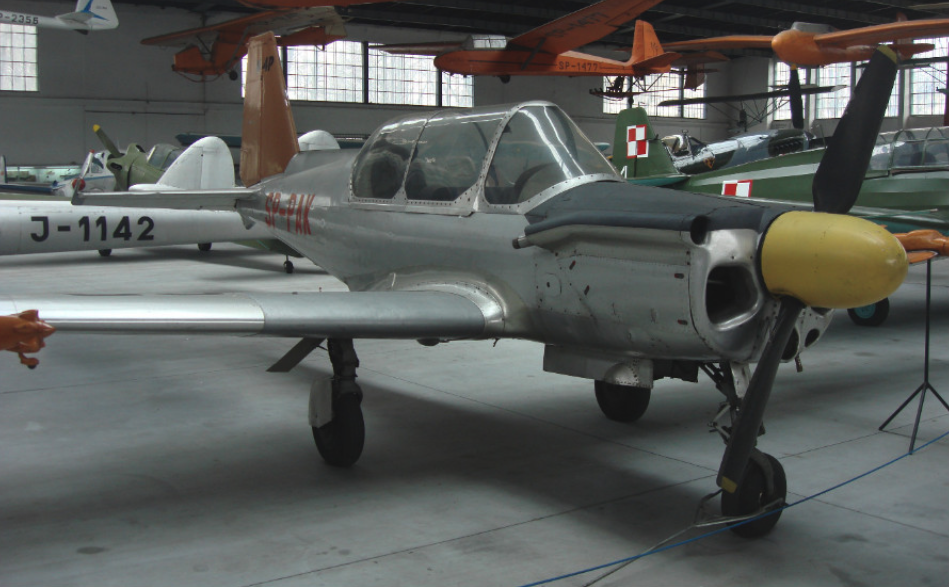174b Section 1961-09-07
History PZL M-4 Tarpan


On June 23, 1958, the PZL M-2 training plane was tested in Mielec. The plane was to go to the Aeroclubs. In 1958, three copies were built. It turned out, however, that the plane, having a fixed, three-support landing gear, with a tail wheel, was not very suitable for training at the Aeroclub. Why? In 50 years, the Aero Club of the Polish People's Republic prepared pilots for the Polish Military Aviation, where the basic plane was the Lim-2, with a front wheel and retractable in flight. And it must be remembered that the Aircraft Club of the Polish People's Republic was headed by officers of the Military Aviation. Therefore, officially the Aero Club of the Polish People's Republic, placed an order for a training aircraft, which was designated PZL M-4 Tarpan. The plane was to have a three-support landing gear, with a front wheel, in a fully retractable system.
The PZL M-4 Tarpan was developed at the WSK-Mielec Aviation Design Center. Engineer J. Olenderka was at the head of the construction team. The preliminary design of the aircraft was ready in December 1958. In 1960, the first prototype was built and the first flight was made on September 7, 1961. The slow working time on the PZL M-4 Tarpan was caused by additional tests on the WN-6 engine and its version WN-6B by engineer Wiktor Narkiewicz. The WN-6 engine was supposed to power training planes, among other things. In principle, an engine with a take-off power of 132 kW (180 HP) at a speed of 2,600 rpm.
In September 1961, the PZL M-4 Tarpan plane was shown at the Aviation Industry Exhibition in Warsaw.
In 1962, the PZL M-4 Tarpan aircraft underwent factory tests. The plane turned out to be stable, controllable and correct in piloting. The plane had good stall properties and performed acrobatics correctly.
In May 1964, the PZL M-4 Tarpan was handed over to the Institute of Aviation in Warsaw for state tests, which the plane passed well. The Institute of Aviation, under pressure from the Association of Aviation Industry, did not issue a decision on the completion of state tests and the aircraft's fitness for production. A list of items for improvement is provided. The plane was transferred to Mielec.
An opportunity to stop further work on the plane was the argument that the required maximum weight was exceeded by 80-100 kg. But if you go into the topic, the suspension of work on the PZL M-4 Tarpan plane, the main reason was - the lack of political will. At the time of the decision to discontinue work on the PZL M-4 aircraft in Mielec, series production was being launched. Already in 1963, the Aero Club of the Polish People's Republic withdrew the order for the plane.
In July 1964, the second prototype, the PZL M-4P version, was flown. The version was adapted to training in navigation flights (SP-PAK registration).
In 1965, both PZL M-4 Tarpan planes were converted to single-seater, aerobatic planes and received the designation PZL M-4A.
In 1971, the plane with the SP-PAW registration was handed over to the Metal Works in Nowa Dęba as a monument, and then scrapped. The second copy, registered SP-PAK in October 1971, was taken over by the Museum of Aviation and Astronautics in Krakow (Polish Aviation Museum) as an exhibit.
Written by Karol Placha Hetman
174b Section 1961-09-07
Construction PZL M-4 Tarpan

The PZL M-4 Tarpan is a two-seat, cantilever low-wing metal structure.
The wing is partially adjacent to the plane fuselage with a trapezoidal contour. Rectangular external parts. The leaf is made of metal, two-part, two-spar, half-shell, covered with a duralumin sheet. The front caisson forms an integral fuel tank in the part by the fuselage. The cover of the caisson within the tank is covered with laminate. Differential, slotted ailerons, coupled with flaps, metal structure, single-spar, covered with sheet metal. Slotted flaps of a construction similar to the ailerons. The relative leaf thickness is 10%.
The fuselage of a semi-shell aircraft. The front part houses the engine, the bed of which consists of two metal beams. The beams run all the way past the crew compartment. The rear part of the fuselage is conical, semi-shell. Sheet metal cover, stiffened with ribs and stringers. On the spine there is an aerodynamic steering wheel, which transforms into a vertical tail. Two-person crew cab in tandem configuration. The cabin is completely covered.
The tail of the plane has a classic, free-bearing, trapezoidal layout. Two-spar ballasts, semi-shell structure, covered with sheet metal, stiffened with stringers. Vertical stabilizer permanently attached to the fuselage. Non-split horizontal stabilizer. Single spar rudders, sheet metal covered. One-piece elevator, not divided.
Three-wheeled undercarriage with front wheel, fully retractable in flight.
Aircraft equipment: Ultra-shortwave radio, on-board radio. The M-4 P version has extensive navigation equipment.
WN-6B in-line, flat engine with a starting power of 136 kW (185 HP) and a continuous power of 118 kW (160 HP).
Data T-T PZL M-4:
Span 8.85 m. Length 7.35 m. Height 2.61 m. Bearing area 11.79 m2. Curb weight 888 kg. Payload 312 kg. Gross weight is 1,200 kg. Top speed 300 km / h. Cruising speed 260 km / h. Landing speed 106 km / h. Rate of climb 4.2 m / s. Service ceiling 4,400 m. Range 750 km.
Written by Karol Placha Hetman
174b Section 1961-09-07
Tally PZL M-4 Tarpan
Only two planes were built. In 1971, the plane with the SP-PAW registration was transferred to the Metal Works in Nowa Dęba as a monument, and then it was scrapped. The second copy, registered SP-PAK in October 1971, was taken over by the Museum of Aviation and Astronautics in Krakow (Polish Aviation Museum) as an exhibit.
Written by Karol Placha Hetman
